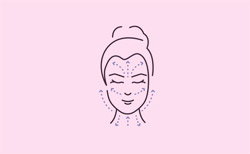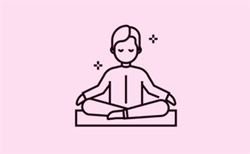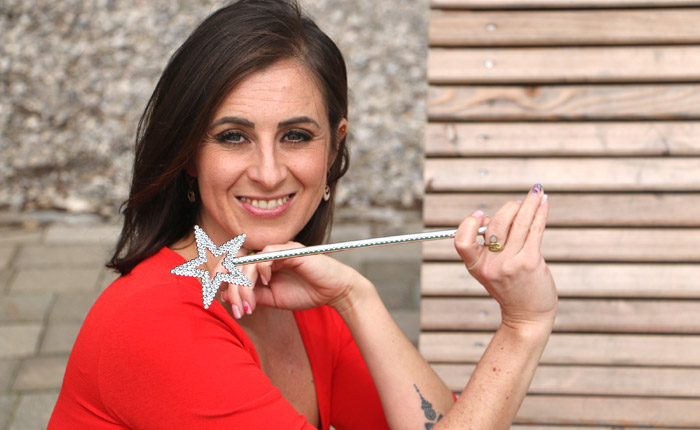Jaw Yoga
What is Jaw Yoga?
Jaw Yoga combines scientifically based methods from orofacial myofunctional therapy, effective techniques from mind and consciousness training, and wisdom from traditional yoga and chakra teachings. This holistic approach naturally and sustainably relaxes the jaw, balances the throat chakra, and promotes long-term jaw health.
Developed through years of collaboration with dentists, Jaw Yoga has been validated for its positive impacts on health and well-being!

Vision
The vision behind Jaw Yoga is to guide people from a state of tension and the constant feeling of "gritting their teeth" to a state of enthusiasm and joy, feeling truly JAWSOME! Jaw-stress keeps people in protective mode, disrupting communication and connection with others. We believe that a relaxed jaw not only brings inner peace and contentment but also fosters authentic relationships and deeper connections.
At Jaw Yoga, we envision a world where people are free from tension, stress, and pain, yet feel jawsome with a balanced jaw and throat chakra. Inner smiles emerge as we courageously and authentically live our passions and lead self-determined lives. Imagine a world where everyone listens to their inner voice, fostering genuine, empathetic communication that transcends cultural and language barriers. We believe Jaw Yoga plays a pivotal role in realizing this transformation!
Mission
Our mission is to empower individuals worldwide to achieve jaw balance through holistic practices and self-awareness. By providing comprehensive Jaw Yoga programs, we aim to equip people with the tools to resolve jaw-related issues and cultivate sustainable well-being. We are dedicated to fostering a community where every individual feels jawsome – joyful, empowered, and aligned with their inner voice – contributing to a world of harmonious and authentic connections.
Because with a balanced jaw system, individuals return to a growth mode, living self-determined lives and engaging communicatively with others. Jaw-Yoga is the key to a deep connection with ourselves and our fellow human beings.
4 Pillars
Jaw Yoga Foundations

Jaw Yoga BODY
Discover over 80 exercise sequences for sustainable jaw relaxation.
Specialized muscle function, fascia, and breathing exercises bring the jaw system to relaxation and balance. Central to this is tongue resting position training, which ensures lasting results.

Jaw Yoga BRAIN
Brain training for enhanced stress resistance and better coordination.
Complex functional and coordination exercises engage visual, auditory, and proprioceptive senses, forming new synapses in the brain. These connections promote mental flexibility, stress resistance, perceptiveness, adaptability, and creativity.

Jaw MEDITATION
Deep relaxation and clarity for your jaw.
Jaw meditations facilitate profound relaxation of the jaw, bring awareness to your jaw-related issues, and effectively reduce jaw stress.

Jaw Yoga MIND
The mind-full-ness training for a healthy jaw.
Our specialized mind and awareness training addresses harmful habits, patterns, and conflicts underlying jaw issues. This approach simplifies the resolution of jaw stress causes at a mental-emotional level. Balancing the throat chakra also enhances self-determination, self-expression, and communication.
Jaw Yoga
The Story

The story of Jaw Yoga began in 2013 with the development of a Mental Muscle Function Training aimed at supporting speech therapy in learning the correct tongue rest position.
Julia Reindl specialized in the therapy of jaw function disorders and spent 9 years in clinical therapy and research. She discovered the pivotal role of the tongue in the jaw system, leading to the development of "Jaw Yoga BODY" – a scientifically based exercise program for jaw relaxation, available since 2016 in the 'Kieferfreund App'.

Julia Reindl was additionally afflicted with dental and jaw misalignments, pain, and jaw mobility restrictions since childhood. Conventional medicine did not offer sustainable relief, prompting her to take personal responsibility in seeking alternative methods.
Reinhard Burits (+2022) was a passionate mind and consciousness trainer with extensive experience in body and personality work. His work revealed the proverbial 'clenching' in the jaw caused by stress and pressure, and its detrimental effects on individuals.
Together, they expanded the method to include "Jaw Yoga MIND" to address the causes of jaw-stress at the cellular level and "Jaw Yoga BRAIN" to enhance stress resiliance and neuroplasticity.
Felix Neubauer is a co-developer of the Kieferfreund App and an experienced mindfulness coach from England. In 2021, he developed his unique jaw meditation techniques, providing rapid relaxation for our clients worldwide.
Jaw Yoga
9 Unique Reasons for Jaw Yoga:
Jaw Yoga positively impacts the entire body, mind, and spirit, as the jaw is closely connected to life and experience:
-
Jaw Yoga is based on the natural, healthy function of body and mind, enabling sustainable jaw relaxation (not only for teeth grinding, tongue pressing, and snoring).
-
Jaw Yoga includes a scientifically validated training program that has been applied and tested in therapeutic practice for years.

3. Jaw Yoga promotes relaxation, flexibility, mobility, and body awareness.
4. Jaw Yoga reduces stress levels, negative emotions, and overthinking.
5. Specialized breathing exercises enhance your health and performance.
6. Balancing the throat chakra supports a strong voice and clear speech expression.
7. Opening the throat chakra gives you access to your intuition and helps you stand up for and express your needs.
8. Jaw Yoga is a fountain of youth: relaxed facial features and an inner smile elevate your attractiveness to a new level!
9. Jaw Yoga brings enthusiasm into your life! Feel JAWSOME!
Effectiveness scientifically proven
Study
Observation of pain reduction in people with jaw dysfunctions by applying the jaw yoga method with the help of the Kieferfreund app.
Introduction: The aim of this study is to evaluate the effects of relearning the physiological tongue resting position as part of Jaw Yoga training on pain reduction in the jaw area using the Kieferfreund App.
Materials and Methods: A total of 15 participants with temporomandibular joint disorder (TMD) were clinically examined, followed by completion of a questionnaire by the subjects.
Results: The results indicate that participants experienced significant reductions in jaw pain both at rest and during chewing (mean difference [95% CI]). Symptoms such as jaw joint sounds (93%), bruxism (80%), and frequent head/earaches (67%) also showed improvement or remained unchanged.
These findings correlate with the range of motion measurements of the mandible conducted by the study leader.
Continuation:
Relevant improvements were measured in maximum mouth opening and mandibular protrusion following the Jaw Yoga training program. Additionally, fewer jaw muscles exhibited pain upon digital palpation.
At the outset, none of the participants reported maintaining the correct physiological tongue resting position in daily life. During the training program, the physiological tongue resting position was largely automated and transferred to daily life (67%). These results are consistent with findings indicating that tongue resting position influences jaw muscle tension.
The project also examined changes in participants' perceived stress levels. No significant variance was found before and after training on an ordinal scale based on subjective assessments, ruling out the possibility that stress levels influenced symptoms.
Conclusion: This study represents an initial exploration into the effects of tongue resting position within the Jaw Yoga training program concerning temporomandibular disorders (TMD).
Scientific studies as the foundation for Jaw Yoga BODY
Dr. Engelke, Dr. Jung und Dr. Knösel: "Intra-oral compartment pressures: a biofunctional model and experimental measurements under different conditions of posture" Clin Oral Investig. 2011 Apr;15(2):165-76.doi: 10.1007/s00784-009-0367-0. Epub 2010 Feb 2.
Sandra Kahn, Paul Ehrlich, Marcus Feldman, Robert Sapolsky, Simon Wong: "The Jaw Epidemic: Recognition, Origins, Cures, and Prevention" Bioscience. 2020 Jul 22;70(9):759-771. doi: 10.1093/biosci/biaa073. eCollection 2020 Sep.
Bordoni B, Morabito B, Mitrano R, Simonelli M, Toccafondi A. The Anatomical Relationships of the Tongue with the Body System. Cureus. 2018 Dec 5;10(12):e3695. doi: 10.7759/cureus.3695. PMID: 30838167; PMCID: PMC6390887.
Martinelli RLC, Marchesan IQ, Gusmão RJ, Berretin-Felix G. Effect of Lingual Frenotomy on Tongue and Lip Rest Position: A Nonrandomized Clinical Trial. Int Arch Otorhinolaryngol. 2021 Jul 5;26(1):e069-e074. doi: 10.1055/s-0041-1726050. PMID: 35096161; PMCID: PMC8789490.
Tancredi S, De Angelis P, Marra M, Lopez MA, Manicone PF, Passarelli PC, Romeo A, Grassi R, D'Addona A. Clinical Comparison of Diode Laser Assisted "v-Shape Frenectomy" and Conventional Surgical Method as Treatment of Ankyloglossia. Healthcare (Basel). 2022 Jan 4;10(1):89. doi: 10.3390/healthcare10010089. PMID: 35052254; PMCID: PMC8775129.
Engelke W, Engelhardt W, Mendoza-Gärtner M, Deccó O, Barrirero J, Knösel M. Functional treatment of snoring based on the tongue-repositioning manoeuvre. Eur J Orthod. 2010 Oct;32(5):490-5. doi: 10.1093/ejo/cjp135. Epub 2010 Jan 28. PMID: 20110305.



